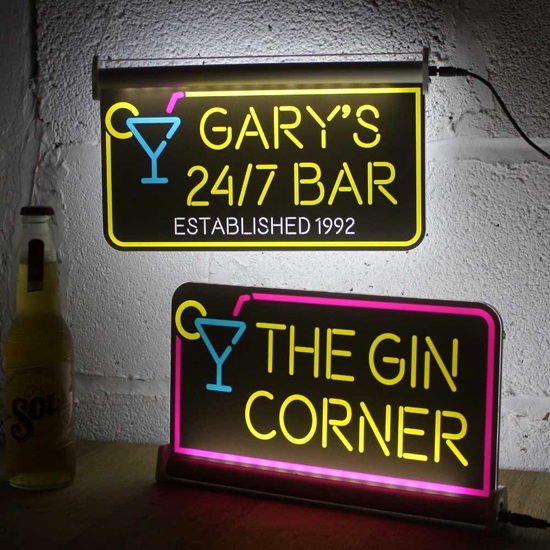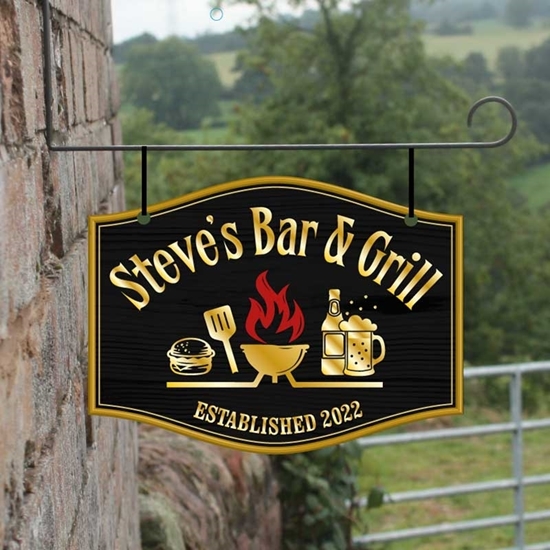Good Facts On Selecting Window Vinyl Signs
Good Facts On Selecting Window Vinyl Signs
Blog Article
What Distinguishes Bar Signs From One Another In Terms Of Style And Design?
The signs for bars differ in style and design to suit the theme, ambiance and target audience of the establishment. Here are a few key styles and designs: 1. Vintage/Retro
The characteristics include a nostalgic, traditional look that is often weathered or distressed.
Design elements: Using retro fonts, aged wood or metal, old-school logos, and old-fashioned graphics.
Uses : Perfect for restaurants and bars that have a a nostalgic feel, such as speakeasies or pubs.
2. Modern
Characteristics: Sleek, clean, minimalist.
Simple geometric shapes and fonts are commonly used, as well as monochromatic or bold colors schemes.
Uses: Ideal for modern bars, upscale lounges, and stylish cocktail bars.
3. Rustic
Characteristics: Natural, earthy, and cozy.
Design elements The use of reclaimed timber hand-painted or carved writing natural colors, rustic finishes.
Uses: Suitable for country-style bars, farm-to-table establishments as well as mountain lodges.
4. Industrial
Characteristics: Raw, unfinished, edgy.
Design elements: Exposed metal pipes, reclaimed material as well as neutral tones as well as bold fonts.
Applications: Ideal for bars in warehouses, lofts and urban environments.
5. Glamorous
Characteristics: Elegant, luxurious, eye-catching.
Design elements: use of gold, metallics (silver and copper. ) and glitter elaborate typography, and elegant graphics.
Uses: Great in high-end bars, nightclubs with high-end amenities, or in any establishment that has a discerning customer base.
6. Nautical
Characteristics of the region: Coastal, marine and adventure.
Design Elements: Anchors, ships, white and blue shades, in addition to rope and wood textures.
Uses: Beach bars, seafood restaurants, and waterfront establishments are perfect for this kind of product.
7. Tropical
Characteristics: Bright, colorful, relaxed.
Design Elements are characterized by bright colors tropical flowers, fun typefaces and beach imagery.
Uses: Perfect for beach bars, tiki bars and other establishments with a theme of islands.
8. Sport
Characteristics: Energetic, team-oriented, spirited.
Design elements: Team logos or sports imagery. Bold colors. Modern fonts.
Uses : Ideal for bars with a focus on catering to fans of sports including pubs and fan zones.
9. Steampunk
Characteristics: Futuristic, Victorian, mechanical.
Design elements: gears, cogs and pipes, leather textures, antique fonts, brass textures.
Applications: Great for bars with a mix of modern and historical themes.
10. Art Deco
Characteristics: Glamorous, geometric, bold.
Design elements: Geometric patterns, gold and black color schemes, symmetrical designs and beautiful fonts.
Uses: Ideal for bars that want to look elegant in the 1920s Gatsby.
11. Humorous/Quirky
Characteristics: Fun, light-hearted, engaging.
Design elements: animated graphics, playful fonts, slogans with humor, and cartoonish graphic.
Uses: Perfect for dive bars, casual bars, or places that are looking to create a relaxed and fun atmosphere.
12. Traditional Pub
Characteristics: Warm, inviting, classic.
Design elements Dark woods, traditional fonts, heraldic images and classic pub pictures.
Uses: Great Uses: Perfect for British pubs as well as Irish pubs and establishments with a classic European vibe.
13. Western
Characteristics: Rustic, rugged, cowboy-themed.
Design Elements : wood textures, cowboy images rope fonts Earth tones.
Uses: Perfect for bars with themes of the west, BBQ joints and country music venues.
14. Neon
Specifications: Bright, vibrant, and attention-grabbing.
Neon Lights Design Elements, in a variety of colors and typically with simple and striking graphics.
Applications: Ideal for trendy bars, clubs and other places that want to create an energetic ambience.
15. Minimalist
Characteristics: Simple, clean, understated.
Design elements: Minimal text and graphics. Colours that are limited or monochromatic designs. Sleek fonts.
Applications : Ideal for modern, high-end bars which want to give a a chic feel.
Bar owners who select the appropriate style and design can develop a design that is cohesive and enhances the customer experience. It also reinforces their bar's theme. Take a look at the top rated hanging pub signs examples for website examples including pub signs for home bars, pub signs, garden pub signs, bespoke bar signs, large pub sign, personalised hanging pub signs, to the pub sign, pub signs for garden bar, personalised home bar signs, personalised metal bar signs and more.
What Is The Difference Between Bar Signs With Regards To Durability?
Durability of bar sign depends on numerous factors such as the materials used, their construction and use. These are the most important elements that impact bar signs their durability. Material
Metal signs are impervious to corrosion and durable and can therefore be used in the outdoors.
Wood: Solid wooden signs are long-lasting, but they may need regular maintenance to prevent the wood from rotting or bending.
Acrylic: Acrylic signs are able to be used outdoors and are long-lasting.
The difference between LED and neon is that neon signs are brittle and easy to damage. However, LED signs are energy efficient and durable.
2. Weather Resistance
Outdoor Signs: Materials and coatings for signs exposed to the elements outdoors must resist fading, corrosion and water damage.
Indoor Signs: Even though they're not subjected to extreme conditions, indoor signs must be able to withstand humidity, temperature fluctuations, and wear and tear.
3. Construction
Signs that have solid construction, like reinforced corners and sturdy mounting hardware, are less prone to destruction.
Signs sealed with sealed electronic components (for illuminated signs) are less prone to water-related damage.
4. Maintenance Requirements
Low Maintenance: Signs that need little maintenance, like frequent cleaning, are more suitable for busy bar owners.
Signs that require high maintenance: Signs with intricate designs or materials can be laborious and costly to maintain.
5. Location
Indoor Signs: Because indoor signs are generally less vulnerable to environmental hazards the requirements for their durability could be less than those for outdoor signs.
Outdoor Signs: Outdoor signs require greater durability to withstand exposure to sunlight, rain, wind and temperature fluctuations.
6. Resistance to Impact
Signs that are Heavy Duty: Signs meant for areas that have a lot of traffic or in areas where they could be damaged (e.g. bars) should be constructed of sturdy materials to resist scratching or denting.
Signs that have laminated or protected surfaces are less prone to be damaged by spills, scratches or vandalism.
7. Longevity
Longevity. The signs that last will last long with little or no deterioration. They're a good investment for bar owners.
Signs with a Short-Term Use The signs that are designed to be used temporarily for events or promotions, might not need as long-lasting as permanent signage.
8. Lighting
Lighting Components: Illuminated signs with LED or neon lighting should be made of high-quality, long-lasting components to ensure longevity and durability.
9. Environmental Impact
Signs made of recycled and sustainable materials may lessen the impact on the environment. They offer quality and durability.
10. Customization
Custom Options Signs that permit customization have different durability levels dependent on the materials used and production methods.
Durability The benefits of durability
Cost-Effectiveness Durable signs require less maintenance or replacement. This decreases the cost of maintenance over time.
Brand Image High-quality, durable signs reflect the positive image of your bar and professional.
Customer Satisfaction- Signs in good condition improve the general atmosphere of the bar and create a the satisfaction of customers.
By considering factors such as the material, construction and maintenance requirements bar owners can select signage solutions that offer the required durability to stand up to the demands of their surroundings and offer long-lasting value to their establishment. Check out the top https://twofb.com/ for more advice including personalised cocktail bar sign, home pub signs, personalised pub, personalised pub, signs for garden bar, hanging home bar signs, make your own bar sign, pub wall sign, bar signs for garden, personalised hanging bar sign and more.
How Are Bar Signs Different From Regulations?
Bar signs are subjected to a variety of regulations by local, state and federal authorities in order to protect the public and aesthetic standards, as well as compliance with zoning law. Here are the differences between bar signs and their rules. There are rules regarding the size and position of signs.
Zoning Laws: Regulations dictate the location of signs as well as their size, height, and distance from property lines, roads, or neighboring buildings.
Historic Districts: Signs could be restricted in order to maintain the historical character of certain districts. This may include restrictions on size, design and materials.
2. Illumination Restrictions
Light Pollution: Regulations can limit the brightness, colors and duration of illuminated signs in order to limit light pollution and preserve the nighttime ambience.
Safety considerations Signs should not create glare and should not be distracting for drivers or pedestrians, especially when placed near the road.
3. Content of the signage
Alcohol Advertising: Some jurisdictions have restrictions on alcohol advertising that prohibit certain types of images or contents that might attract minors or encourage excessive drinking.
Health Warnings: The law could mandate health warnings be displayed on signs about smoking and drinking alcohol.
4. Historic Preservation Regulations
Architectural Compatibility: Signs in historic districts need to be in line with the architectural style and character of the district, usually needing approval from preservation commissions or boards.
Material and Design Signs that are considered to be historical in significance may be subject to restrictions on the materials used or the style and color scheme.
5. Sign Permitting Process
Permit Requirements Bar owners need to obtain permits before they can install or alter signs. This can involve paying costs, making submissions, and getting local authority approval.
Code compliance: Signs should comply with the construction codes, fire safety standards, as well as accessibility guidelines, to guarantee safety for the public.
6. Repair and removal of signs
Maintenance Requirements. It is the responsibility of the bar owner to ensure that signs are maintained in good condition solid and structurally sound without dangers and that they are in accordance with rules and regulations.
Abandoned or Dilapidated Signs: In order to avoid destruction and to preserve the aesthetics in an area, there could be laws regarding the destruction of signs that are abandoned or dilapidated.
7. Digital Signage Regulations
Content Restrictions: Laws may regulate the content that is displayed on digital signs, including the prohibition of certain kinds of content, such as flashing lights, or images that are offensive.
Limitations on Operational Signs To reduce visual clutter, laws may limit the luminosity of digital signage, their motion or their frequency of changes.
8. Enforcement and Penalties
Inspections: The local authorities regularly inspect signs to ensure they're in compliance the signage regulations. They issue citations in the event of there are any violations.
Penalties: For non-compliance, penalties may include fines or citations. These could also be orders to take down signs or modify them, or even legal action.
9. Sign Variance Process
Variance applications: Bar owners who wish to alter their signage in accordance with the regulations can do so by submitting a request for a variance. Justification should be provided as well as any negative effects on the public's security or appearance must be considered.
Public Input. Variances could need public hearings or participation from members of the community. This could include neighbors, property owners or business associations as well as residents of communities that are adjacent to each other.
10. Engagement and participation of the Community
Public Consultation Some jurisdictions engage community members to help develop sign regulations, either through public meetings, surveys or stakeholder consultations.
Sign regulations could have community benefits for the community. Sign regulations can include provisions to improve the quality of signage, advertise local business, or help revive neighborhoods.
Bar owners who understand and follow signage regulations can make sure that their signs are appealing to customers, thereby contributing positively to their community and meeting the legal regulations. This can reduce the possibility of legal disputes, fines or penalties. See the top what do you think on gin bar sign for website tips including personalised metal bar signs, buy bar signs, indoor bar signs, pub signs to buy, home bar pub signs, a bar sign, bar sign outdoor, home garden bar signs, bar sign outdoor, make a bar sign and more.